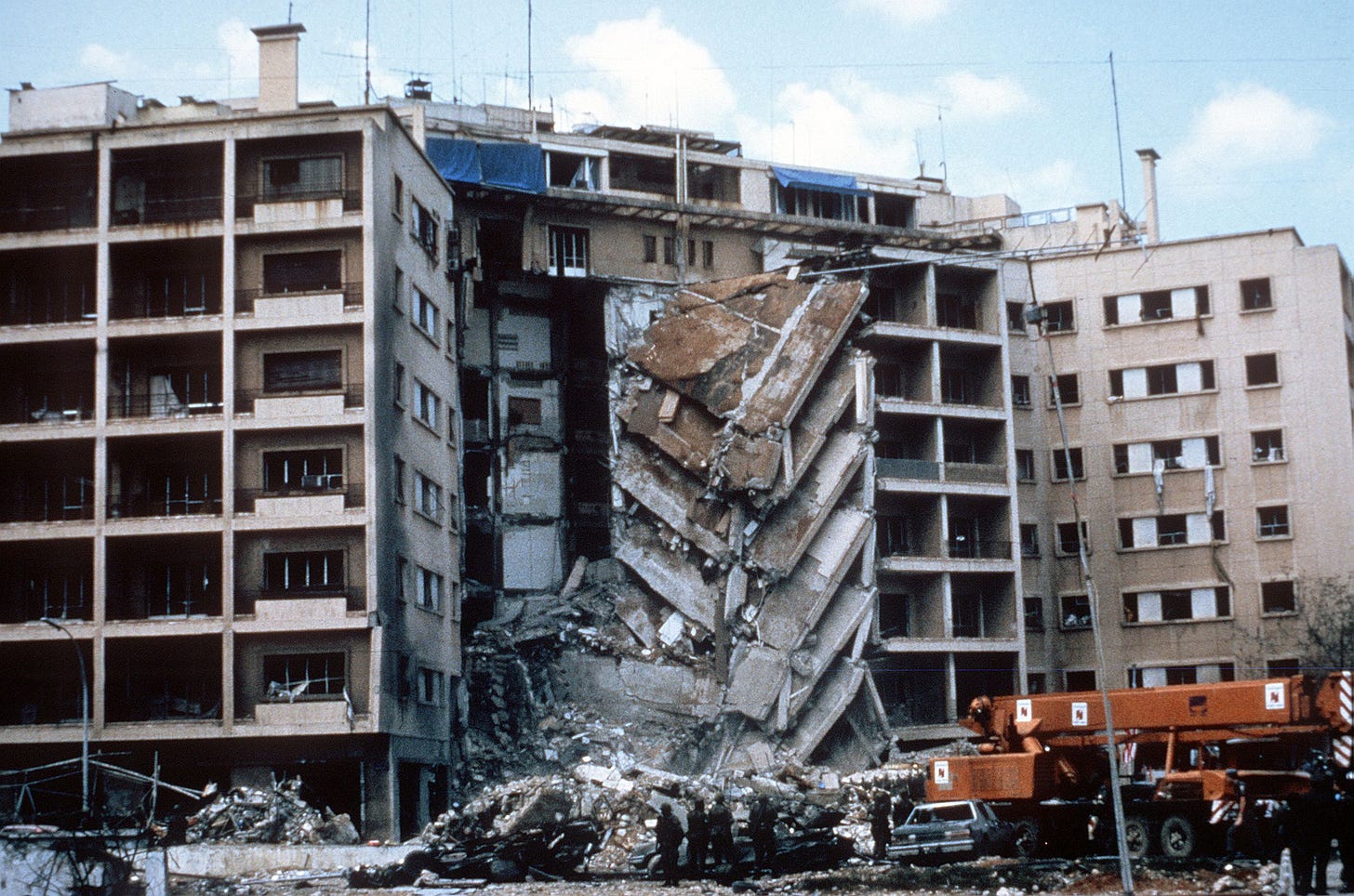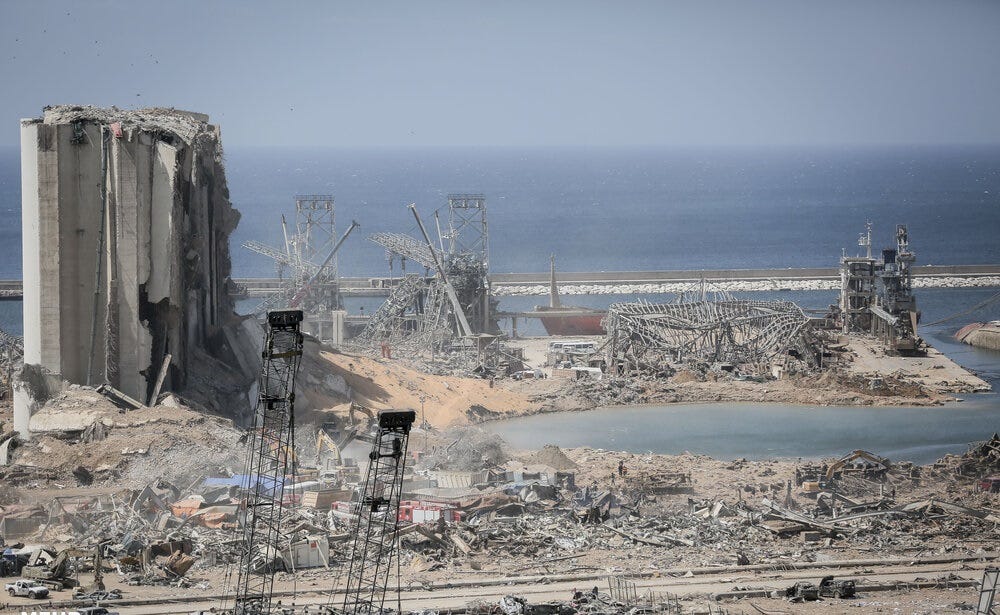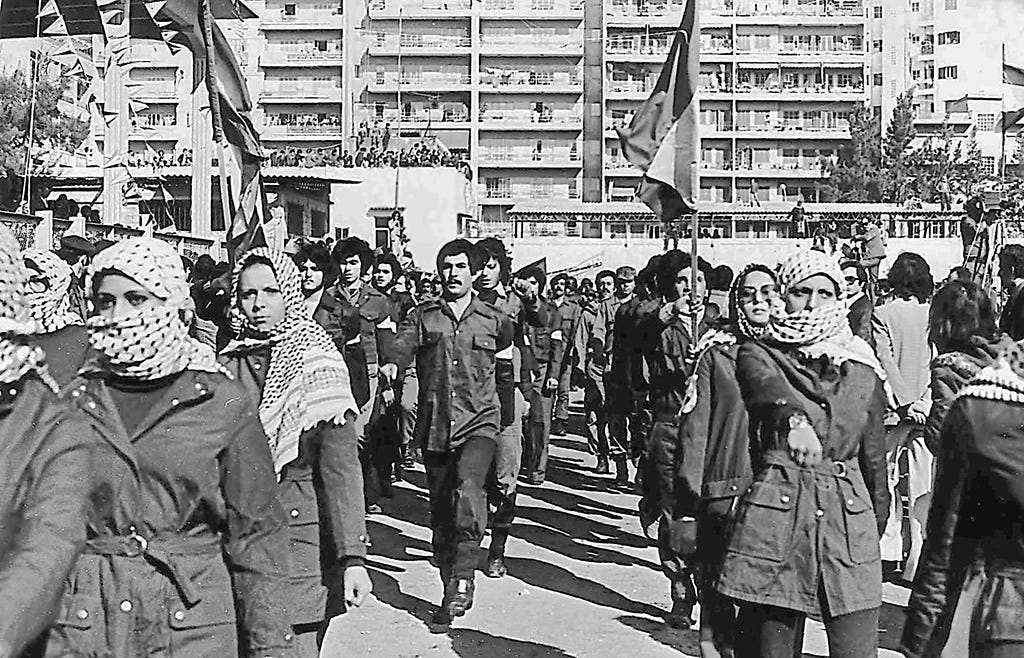The Burning Choice for Lebanon: Peace with Israel or War with Hezbollah
What happened to Lebanon? In two words: radical Islam. In three words: Palestinians and radical Islam. The U.S. has also played a significant role in the wreck, as has the abominable Iranian regime.

Please consider supporting our mission to help everyone better understand and become smarter about the Jewish world. A gift of any amount helps keep our platform free of advertising and accessible to all.
You can also listen to the podcast version of this essay on Apple Podcasts, YouTube Music, YouTube, and Spotify.
In a rare English-language video published Tuesday, Israeli Prime Minister Benjamin Netanyahu called on the Lebanese people to save their country by ousting the Iranian proxy terror group Hezbollah from Lebanon — once known as the “Pearl of the Middle East.”
Lebanon’s history is marked by a rich tapestry of cultures, religions, and civilizations. Ancient Phoenicians, known for their maritime trade and city-states like Tyre and Sidon, flourished in the region around 3000 BCE. They contributed significantly to the development of writing, commerce, and navigation.
Over the centuries, Lebanon was influenced by various empires, including the Egyptians, Assyrians, Babylonians, Persians, and Greeks. The Romans later incorporated the area into their empire, and it became a center for early Christianity. By the Middle Ages, Lebanon was predominantly populated by Christians — particularly the Maronites — alongside various Muslim sects, leading to a diverse societal structure.
The 20th century saw Lebanon emerge as a distinct political entity, gaining independence from France in 1943. However, the delicate balance between its Christian and Muslim communities increasingly led to tensions and instability, culminating in a devastating civil war that erupted in 1975.
The Lebanese Civil War was not initiated by a single individual or group; rather, it ensued from the country’s complex interplay of political, social, and sectarian tensions. The immediate catalyst for the war was the growing discontent among the Palestinian refugee population, which had been in Lebanon since the 1948 First Arab-Israeli War (also known as Israel’s War of Independence).
Tensions escalated when armed clashes broke out between Christian militias and Palestinian factions. On April 13th, 1975, a violent incident in the Beirut suburb of Ain El Remmaneh involving the Phalangist Christian militia and Palestinian fighters marked the civil war’s official beginning.
By the late 1970s, the Palestine Liberation Organization (PLO), which relocated to Lebanon after being expelled from Jordan in 1970 after it tried to assassinate the Jordanian king, had established a quasi-state within a state in southern Lebanon. The PLO used this area as a base to launch attacks against northern Israel, which contributed to increasing tensions between Israel and Lebanon.
In the early 1980s, the situation escalated further as PLO cross-border skirmishes and attacks intensified. In June 1982, an assassination attempt was made on Shlomo Argov, the Israeli ambassador to the United Kingdom, by the Abu Nidal Organization, a breakaway faction of the PLO. Although the attack was not directly ordered by the PLO leadership, Israel held the PLO responsible due to its overall control of Palestinian armed groups.
Three days later, Israel launched Operation Peace for Galilee with the declared aim of pushing PLO forces away from its northern border and creating a 40-kilometer buffer zone. The invasion quickly escalated into a full-scale war as Israeli forces advanced towards Beirut, Lebanon’s capital, where the PLO was headquartered — ultimately culminating in the PLO’s withdrawal from Lebanon and relocation to Tunisia.
In the years that followed, the PLO shifted its focus towards a more “diplomatic” (really spurious and haphazard) approach in pursuit of Palestinian statehood, leading to the signing of the Oslo Accords in the early 1990s. This landmark agreement between the PLO and Israel aimed to establish a framework for peace and included mutual recognition and the establishment of the Palestinian Authority to govern parts of the West Bank and Gaza Strip. However, the PLO’s authority and influence were significantly diminished due to internal divisions, rampant kleptocracy and nepotism, and the emergence of competing factions (such as Hamas and Palestinian Islamic Jihad).
Meanwhile, back in Lebanon, Hezbollah (a Shiite political and terrorist group) was formed in the early 1980s. The roots of Hezbollah can be traced back to various Shiite militias, Islamic organizations, and clerics that had been developing in Lebanon since the 1960s, influenced by the Iranian Revolution of 1979, which inspired Shiite groups across the Middle East.
Hezbollah was officially founded in 1985 with a manifesto that featured the expulsion of Western influences from Lebanon, the destruction of Israel, allegiance to Islamic Republic of Iran’s supreme leader, and the establishment of an Iran-influenced Islamist government. As such, the group received overwhelming support from the Jihad-happy Iranian regime, including military training and funding.
Over time, Hezbollah evolved into a significant political force in Lebanon, participating in elections and establishing social services, while also bolstering its military capabilities — the same blueprint that Hamas has followed in Gaza. Today it is considered the most heavily armed non-state group in the world, with its armed strength assessed to be equivalent to that of a medium-sized army.
A few years ago, Hezbollah leader Hassan Nasrallah (who was assassinated last month) said the group had around 100,000 fighters. Some of these fighters executed a cross-border raid into Israel in July 2006, triggering the Second Lebanon War. Hezbollah operatives also launched a missile at an Israeli military patrol along the border and subsequently ambushed IDF soldiers, resulting in the deaths of three Israelis and the abduction of two others.
In response to the attacks, Israel launched a significant military offensive against Hezbollah in Lebanon, targeting infrastructure, military positions, and rocket launch sites. The war lasted roughly one month until a United Nations-brokered ceasefire came into effect, resulting in UN Security Council Resolution 1701. Israel has respected the resolution and Hezbollah, in contravention, did not disarm after Israel’s withdrawal from southern Lebanon.
Since 1990, Hezbollah has officially participated in Lebanese politics, in a process which is described as the Lebanonization of Hezbollah, and it later formed political alliances. In 2008, Lebanon’s new cabinet unanimously approved a policy statement that recognizes Hezbollah’s existence as an armed organization and guarantees its right to “liberate or recover occupied lands.”
Today, Hezbollah is today a key player in the Lebanese political system, and its political wing, the Loyalty to the Resistance Bloc party, holds 15 seats in the Lebanese Parliament. As such, Hezbollah has been described as a “state within a state.”
That said, Hezbollah’s support within Lebanon is limited, especially after being blamed for the 2020 Beirut port explosion, when a large amount of ammonium nitrate stored at the port randomly exploded, causing more than 200 deaths, 7,000 injuries, 300,000 people homeless, and $15 billion in property damage. Hezbollah also obstructed accountability efforts (as would be accustomed of a terrorist organization).
According to a 2024 Arab Barometer survey, 55 percent of Lebanese have “no trust at all” in the group. Support for Hezbollah remains concentrated primarily among Lebanon’s Shiite population, which has historically been one of the poorest and most neglected communities in the country.
One key way that Hezbollah retains this domestic support is through its widespread network of social services. For example, during the 1982 Lebanon War the Hezbollah Martyrs Foundation to support the families of Palestinian martyrs, offering them social, educational, and medical benefits. Over time, the terror group has gone on to operate a variety of religious institutions, schools and educational facilities, hospitals, news services, and agricultural services collectively worth hundreds of millions of dollars per year.

Hezbollah’s secret services have been described as “one of the best in the world.” They have infiltrated the IDF and collaborate with the Lebanese intelligence agencies, which we have the United States to blame, at least in part.
Following the aforementioned 2006 Lebanon War, the petite country came under America’s wings, even as it remained under Iranian influence via its local agent, Hezbollah. This U.S.-Iranian condominium, cemented during Barack Obama’s eight years in the White House, involves America subsidizing the Lebanese security sector, including its two largest institutions: the Lebanese Armed Forces and the Internal Security Forces. The U.S. provides arms, training, and equipment to these forces, and during the past year, American taxpayer dollars have also funded their salaries.
Right from the start, the Lebanese security forces used U.S. training and equipment to uncover Israeli spy cells gathering intelligence on Hezbollah. In 2009, the Internal Security Forces detected an Israeli breach of Hezbollah’s ranks. The then-head of the Internal Security Forces called the terror group’s intelligence chief and told him: “You’ve been infiltrated.”1
After Hezbollah and the Internal Security Forces exchanged information, Hezbollah reportedly took over surveillancing, apprehending, and interrogating the spies. Following the assassination of Hezbollah senior commander Imad Mughniyeh in Damascus the previous year, the Lebanese Armed Forces gave Hezbollah a counterintelligence boost by catching Israeli spies in eastern Lebanon.
“With that offer, the Internal Security Forces essentially was telling Hezbollah, ‘the assistance we are getting from the U.S. is not targeted against you. To the contrary, it can be of benefit to you. It is our duty, as a security organ of the state, to defend Lebanon and every Lebanese against all external threats, the Israeli enemy chief among them. So American assistance can be a boon to you as well,’” according to Tony Badran, a research fellow at the Foundation for Defense of Democracies, where he focuses on Lebanon, Hezbollah, Syria, and the geopolitics of the Levant.2
“It’s hard to argue with the notion that funding the security arm of an Iranian-backed pseudo-state run by a terror army that has murdered hundreds of Americans and targets America’s only useful military ally in the region is the furthest thing from a wise or sane investment,” added Badran.
Inspired by fear and a desire to foment favor, Lebanese security institutions redirected the signal-detection equipment provided by the U.S. to fight Islamic militants — and used it against Israel instead.
“Under the terms of the arrangement with Hezbollah, the Lebanese Armed Forces and Internal Security Forces are allowed, even encouraged, to use American support to Hezbollah’s advantage by focusing on Sunni Islamic groups (that is, those not already working or aligned with Hezbollah) and on Israel,” according to Badran, adding that the counterintelligence collaboration between Hezbollah and Lebanon’s security services has continued uninterrupted ever since.
“In recent years, Lebanese Armed Forces and Internal Security Forces counterintelligence units have proved their worth to Hezbollah by uncovering Israeli agents, networks, and spying equipment,” he wrote.
In 2023, the Iranian-Hezbollah-Hamas coordination efforts increased, specifically in Lebanon. The head of Iran’s Quds Force, Esmail Ghaani, arrived in Beirut in early April to meet with the leaders of Hezbollah, Hamas, and Palestinian Islamic Jihad at the Iranian Embassy. From then through September, Hamas and Palestinian Islamic Jihad leaders held meetings with the Iranian leadership in Iran, Syria, and Lebanon, and continued to consult regularly with Nasrallah in Beirut. And Hamas paragliders had been training in Lebanon.
“What seems clear is that, in exchange for the U.S. providing training and equipment, and paying everyone’s salaries, U.S. clients inside Lebanon managed exclusively to provide U.S.-subsidized counterintelligence support to Hezbollah and Hamas that contributed to blinding Israel [on October 7th], while failing entirely to provide the U.S. itself with any relevant information whatsoever,” wrote Badran.
And yet, Israel has been creatively preparing for another war with Hezbollah since 2006. That is almost 20 years — a whale of time — for one of the world’s greatest military, security, and intelligence establishments to handily outmaneuver U.S. incompetence, nefarious Lebanese actors, and Iran’s villainous influence.
Four weeks ago, Shaldag (one of the premier Israeli Air Force commando units) raided and destroyed a secret Hezbollah missile production facility built inside a mountain in Syria.
Then followed the unprecedented pager and walkie-talkie attacks that Israel allegedly launched the following week against Hezbollah in Lebanon and Syria — injuring at least 3,000 Hezbollah operatives — as well as assassinations of the terror group’s top brass, most notably its chief Hassan Nasrallah two Fridays ago. Israel has also eliminated Nasrallah’s replacement, and the replacement of his replacement.
During the last month, Hezbollah rocket attacks on Israel have slightly increased in amount, range, and damage — amounting to between 100 to 200 per day — but they do not remotely match the uptick in attacks that Israel has justifiably unleashed. It seems that Israel upped the ante significantly and Hezbollah cannot keep up.
Even when Hezbollah tries to launch rockets at Israel, the IDF preemptively attacks Hezbollah’s weapons stores and missile launchers, greatly minimizing their output. In instances when Hezbollah does successfully send a volley toward Israel, the IDF almost-instantly detects the source of fire and counterattacks to destroy it.
Meanwhile, the people of Lebanon suffer because Hezbollah, with Iran’s tremendous help and America’s tremendous ignorance, has hijacked the storied country — a former financial and cultural hub for investors and travelers, earning another nickname, “Switzerland of the East,” some several decades ago.
The capital city Beirut, which tourists dub the “Paris of the Middle East,” is becoming accustomed to Israel’s near-daily aerial assaults because that is where Hezbollah made its headquarters. On a square in downtown Beirut, displaced families with young children huddle on patches of grass that they now call home. One parent tells her children that Israel’s attacks are “fireworks.”3
So, what the heck happened to Lebanon?
In two words: radical Islam. In three words: Palestinians and radical Islam.
Exhaustive negotiations conducted over the past year between Israel and Hezbollah, by the U.S. and France, did not lead to a so-called diplomatic agreement, mainly because no agreement can be reached when the subjects and donors are neither Lebanon nor Israel, but the Islamic Republic of Iran which scandalously pulls strings and dictates objectives.
There is also a basic and obvious issue at the heart of this conflict: A terrorist organization operating from within a state does not void the state of responsibility. The war between Israel and Hezbollah is a war within Lebanon. From Lebanese territory, a war with Israel began on October 8th, 2023, when Hezbollah started attacking Israel’s north “in support of Gaza.”
One reason for Iran’s success is that the U.S.-led West ignorantly agrees to separate Lebanon from Hezbollah — a fundamental and remarkable mistake. Israel is at war with Lebanon, a war that forced Israel to evacuate the northern part of its country, turning some 60,000 Israelis into refugees in their own land and subjecting over a million more to Hezbollah’s rockets, mortars, and anti-tank missiles daily for an entire year.
In the last Lebanese elections, Hezbollah supporters won 60 seats, including 13 held by Hezbollah itself. Nearly half of these delegates are under the terror group’s control, and two ministers serve on its behalf in the Lebanese government. Therefore, any distinction between Hezbollah and Lebanon is artificial and far-fetched. Hezbollah is a Lebanese party with a military force that is orders of magnitude larger than the Lebanese army’s — and the terror group’s arsenal is similar in strength to a midsize European power.
Yet Lebanon has managed to create the image of a peaceful, blameless country, of which Hezbollah is neither a part nor in control. It is pertinent to expose this deception: The terrorist organization is a major component of Lebanon.
Therefore, we must treat the territory known as Lebanon like a sovereign one where there is one government, one flag, and one army. Any negotiations to end the war and security arrangements must be exclusively with the Lebanese government.
Beyond the fact that this can end the war by ensuring long-term stability, Iran (Hezbollah’s chief sponsor) will lose a critical piece of its power and the so-called “ring of fire” around Israel will fade. Moreover, Hezbollah’s activity throughout the region will weaken and the Middle East’s geopolitics will change (mostly in the West’s favor, Israel notwithstanding).
Make no mistake: This war was imposed on Israel. Lebanon joined it one day after the massacres and kidnappings in Israel on October 7th, as part of a coalition with Hamas, Palestinian Islamic Jihad, militias in Syria and Iraq, and the Yemen-based Houthis. Israel cannot accept that, at the end of this war, there will be a state within a state, no less an “independent” military operating to the tune of Iran’s profusely anti-Israel and anti-Western interests.
Israel has already demonstrated its genuine willingness to enter into direct negotiations with the Lebanese government in order to settle all disputes. The Israelis are not asking for much, mainly that one of the world’s largest terror groups backs off from its northern border so hundreds of thousands of civilians can live with peace of mind.
If the Lebanese government decides, implicitly or otherwise, that war with Israel is the way to resolve disputes, the Lebanese people only have to look down the road at the Hamas-created conditions in Gaza to understand what their fate will be.
“Lebanon better able to catch alleged Israeli spies.” Los Angeles Times.
“Eyeless in Gaza.” Tablet.
“‘I tell them it’s fireworks’: Families in Lebanon try to reassure children on the patches of grass they now call home.” Sky News.



The article hits the nail on the head in calling for a decisive stand against Hezbollah's destructive influence, recognizing that Lebanon’s future hinges on choosing peace over extremism. With courageous leadership, the Lebanese people can reclaim their country's legacy and move toward a brighter, more secure future.
Gee whiz. And you wonder why the Israelis did not inform and consult with the Jobamala Administration before eliminating the Hezbollah leadership?